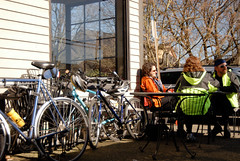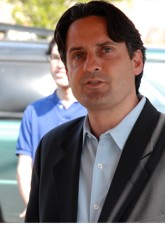Last night at the headquarters of the Sellwood-Moreland neighborhood association, about 50 residents showed up to learn more about the City of Portland’s plans to create a bicycle boulevard on SE Spokane Street.
They got a chance to see some of the latest innovations in the city’s toolbox for creating successful bike streets that co-exist with the livability and business needs of the surrounding neighborhoods.
Progress on this project is a welcome development from local residents. Over a year ago, the Sellwood-Moreland Improvement League (SMIL) sent a letter to the Bureau of Transportation (PBOT) endorsing the bike boulevard. In part because of that broad community support, when Sam Adams took over as mayor earlier this month, he included Spokane as one of three bike boulevard projects to be fast-tracked for completion by the end of the year (along with N/NE Going and N Wabash).
Funding for this $80,00 project is coming from two sources; $30,000 will come from PBOT through their Community and Schools Traffic Safety Partnership program (funded through traffic fine revenue) and the other $50,000 will come from the city’s Bureau of Environmental Services’ “Green Streets” program.
PBOT’s Mark Lear is helping spearhead the city’s bike boulevard effort. Reached by phone this morning, Lear said Spokane is a “key bike boulevard connection” because it connects the Springwater on the Willamette to the Springwater Trail and because it “has strong significance to the regional trail network and the bike boulevard network.”

because of it’s connection to
the Springwater Trail and its
proximity to Sellwood businesses.
Besides creating a comfortable and connected bike route, the city has two main goals with the Spokane bike boulevard; to improve the safety of the crossings at SE 13th and 17th and to minimize cut-through traffic on Spokane (thus making it a nicer place to bike).
In 2001, the city completed a major “road diet” project on SE Tacoma Blvd. (a major street that turns into the Sellwood Bridge, one block south). The result of that project was an increase in motor vehicle traffic on Spokane, especially during the morning commute hours.
To address the safety of crossing Spokane at 13th and 17th, Lear confirmed that PBOT will work with the Oregon Department of Transportation to create a new, 20 mph business district speed zone (ODOT must sign-off on any speed limit adjustments). Also proposed to improve the safety of those crossings is a 20-foot long pedestrian island, marked crosswalks, and new bike/ped signage.
To make the street less appealing for motor vehicle traffic, the Sellwood neighborhood is supportive of PBOT’s proposal for new diversion methods at SE 7th, 13th, and 16th.

at SE 13th and SE 16th.
At 13th and 16th, the proposal is to install “semi-diverters”. These would be similar to the existing diverters on the Clinton bike boulevard at SE 39th. On that street, bikes get the exception to ride eastbound and they are separated from motor vehicle traffic by a double-yellow line (see photo at right). The new diverters proposed for SE 13th and 16th would place a concrete median between the bike and car traffic.
Another proposal for the crossing at SE 13th, that Lear said had the most support at last night’s meeting, was to add a full concrete median (with a pass-through for bikes, similar to SE Ankeny at 28th). That diversion method would restrict motor vehicle left turns off of 13th. (See below for concept drawing).
SMIL president Paul Notti is very excited about the 13th Ave median, saying, “I see it as being very positive for the neighborhood.”

“pinch point” diversion concept.
At SE 7th, a new (for PBOT) and innovative “pinch point” method is likely to be built. The idea with a pinch point is to act as a “gateway” onto the bike boulevard and to ensure that bikes are not pinched into the shoulder of the road by motor vehicles. Two, semicircular concrete medians would be installed in the roadway, narrowing the width of the motor vehicle travel lane while providing a safe, protected buffer space for bike lanes on each side.
To further improve the biking experience on SE Spokane, PBOT will plan to flip three stop signs — at SE 9th, 11th, and 15th — leaving only the stop signs for the major arterials of SE 13th and 17th in place. In order to ensure that motor vehicle speeds don’t increase as a result of those flipped stop signs, PBOT has a contingency plan to analyze existing speed bumps and possibly add others (current speeds on SE Spokane average about 22 mph according to PBOT).

Another new treatment that riders will see on the Spokane Ave bike boulevard will be improved pavement markings. Every 300-350 feet or so, PBOT plans to lay down a new marking that will be significantly larger than the existing “dots”. According to Mark Lear, the design will be based on the existing bike lane symbol and will be placed directly in the roadway (stay tuned for visuals).
Also, because the Spokane bike boulevard is funded in part by the BES Green Street program, medians used in the project will be feature plants and bio-swales.

association president
Paul Notti.
SMIL president Paul Notti said one concern he wants to address during the process is that whatever happens to traffic on SE Spokane doesn’t negatively impact SE Nehalem and SE Miller. “We don’t want to just shift the problem,” he said, “we want to solve the problem”.
On the whole, Notti is enthusiastic about the project. He feels it will be a boost not just to biking, but to the health and economic vibrancy of the neighborhood. “I think this will be beneficial for people visiting Sellwood…beyond just bikers going through the neighborhood, it will have a huge impact on our businesses and livability.”
From here, PBOT will put together a refined proposal and meet with the board of the SMIL neighborhood association on March 4th. According to project engineer Scott Batson, the plan will then be turned over to the design team and the maintenance bureau would begin work on the project this summer.


